What you'll learn:
☞ Intro
Authors:
- Eric Helms, Ph.D. – A renowned sports nutritionist, coach, and researcher, Dr. Eric Helms brings his expertise in strength and physique sports to the forefront. With a doctorate in strength and conditioning, he is dedicated to bridging the gap between science and practical application in the fitness world.
- Andrea Valdez – As a highly respected fitness and nutrition coach, Andrea Valdez adds her invaluable insights to ‘The Muscle & Strength Pyramid: Nutrition.’ Her passion for helping individuals achieve their fitness goals and her extensive experience in the field make her an authoritative voice in the realm of nutrition and training.
- Andy Morgan – With a wealth of knowledge in both strength training and nutrition, Andy Morgan is a key contributor to this comprehensive guide. His practical advice and real-world experience make complex nutritional concepts accessible to readers at all levels of fitness.
Together, these authors combine their expertise to provide readers with a holistic understanding of nutrition, training, and lifestyle factors essential for achieving lasting success in the world of strength and physique sports.
The Emotional Toll of Dieting: Pushing your body beyond its natural body-fat range can be emotionally taxing. Contest prep and intense diets can lead to mood swings, food preoccupation, irritability, and even eating disorders in some cases.
Weight-Class Sports and Tracking: In sports like powerlifting or weightlifting, tracking and manipulating body weight are necessary. However, regular weighing and tracking can also lead to disordered eating and body image issues.
The Importance of Tracking: To achieve your goals, you need to consider if, why, how, when, and how much you’ll track your food and body weight. Tracking is essential for certain goals, but it’s crucial to balance accuracy, flexibility, and consistency.
Balancing Accuracy and Flexibility: Being overly accurate can lead to stress and difficulty in maintaining a diet, while being too flexible can hinder progress. Finding the right balance is key.
Avoiding “All-or-Nothing” Thinking: Striving for perfection can backfire. Rigid meal plans, obsessing over macros, and classifying foods as “good” or “bad” often lead to unhealthy relationships with food. It’s better to adopt an inclusive approach to nutrition.
Useful Tracking Tools: If you need to track, digital food scales and body weight scales are essential. Online databases and apps like MyFitnessPal can help you monitor your nutrient intake accurately.
How to Track Food: Weighing foods is more accurate than measuring them by volume. Weigh foods in their uncooked state to ensure consistency. Tracking nutrient intake helps you understand your dietary habits and make informed choices.
How to Track Body Weight: Daily weigh-ins, under consistent conditions, help you create a weekly average weight. Weekly averages are less affected by daily fluctuations and provide more reliable data to gauge your progress.
Introducing the Pyramid:
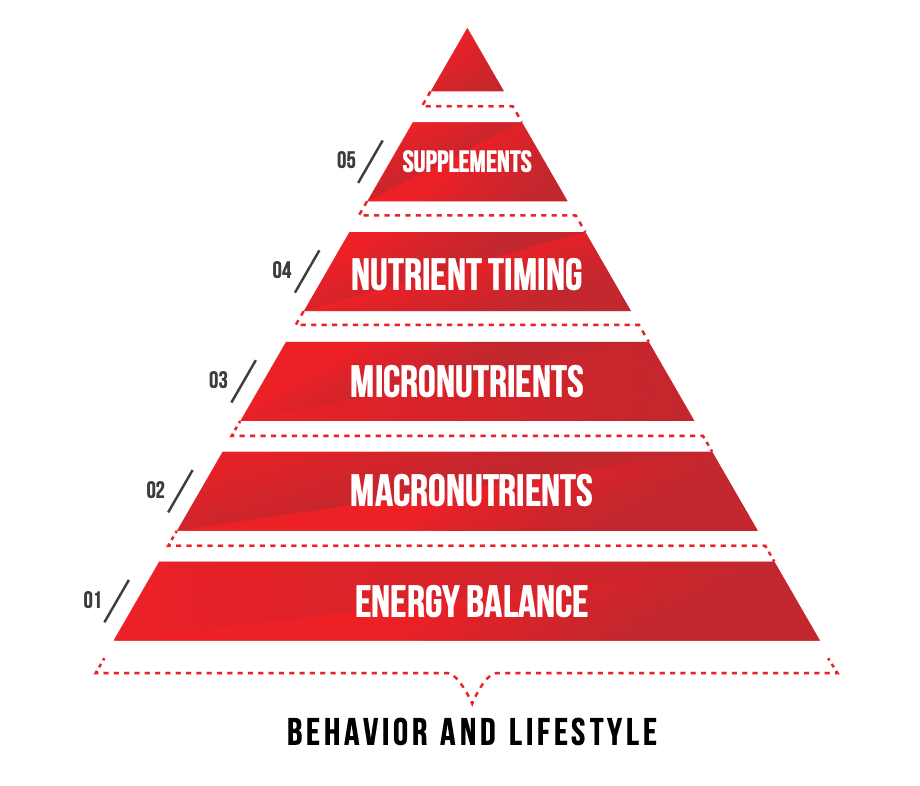
Now, let’s begin our exploration of The Muscle and Strength Nutrition Pyramid, delving into its hierarchical structure. I’ll be presenting these concepts in ascending order of importance, starting from the foundation at Level 1 and progressing to the pinnacle at Level 5.
➡️ Read More: The Muscle and Strength Pyramid (Training Summary)
☞ Level 1: Energy Balance
Advanced Athletes: Advanced athletes, like bodybuilders, may not experience significant changes in their stage weight from competition to competition. Their focus should be on recovery and making gradual improvements in the gym by adding more reps or load over time.
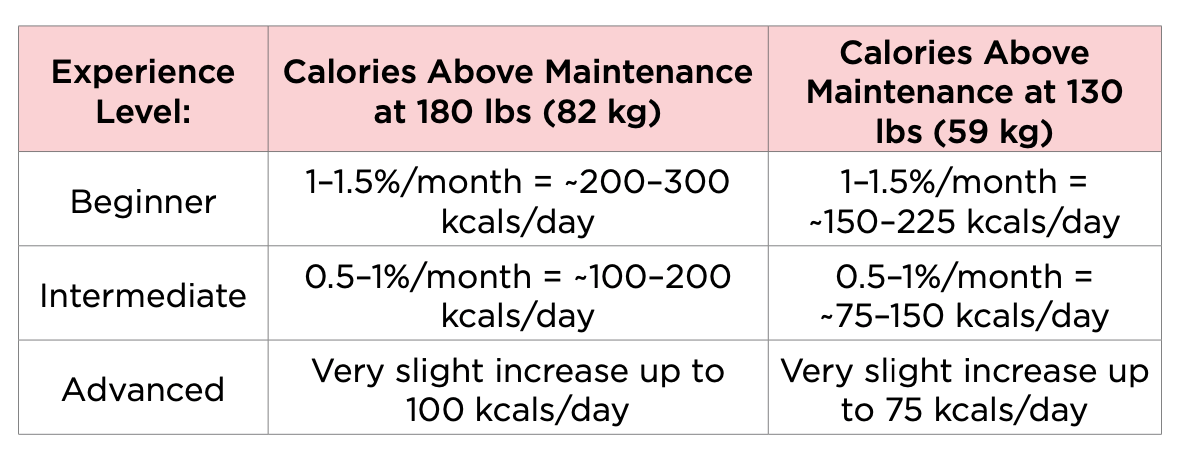
Caloric Value of Muscle: Muscle is energetically costly to synthesize compared to body fat. While fat can be stored with minimal metabolic cost, muscle requires more energy to build and maintain.

3500 Calorie Rule: The “3500 calorie rule” still holds true for setting up diets for both weight gain and weight loss, but it’s important to recognize that the energy value of muscle differs from body fat. Gaining muscle requires more calories than losing fat, which can affect the rate of weight change.
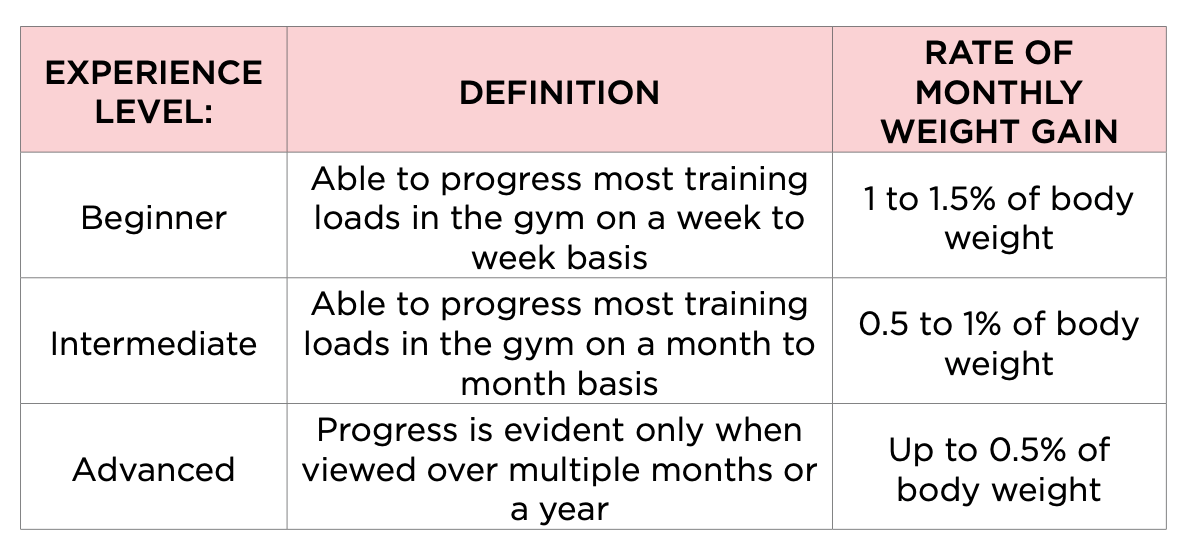
Metabolic Magic: Odd scenarios can occur where individuals gain weight in a caloric deficit or lose fat in a surplus due to differences in water and energy content in different tissues. These scenarios are rare but possible.
Energy Availability: Energy availability refers to whether an individual has enough energy to support exercise and normal physiological functions. Even at caloric maintenance (energy balance), low energy availability can occur, leading to negative health and performance effects.
Relative Energy Deficiency: A lean physique maintained at a lower energy intake than needed can lead to relative energy deficiency, affecting hormonal and metabolic function. This can occur in both men and women and may result in various health consequences.
Thresholds for Energy Availability: While a threshold of 30 kcal/kg lean body mass (LBM) is often mentioned for women, and 25 kcal/kg LBM for men, these values may vary based on individual factors. It’s essential to monitor signs and symptoms of low energy availability and make dietary adjustments accordingly.
Monitoring Signs: Signs of low energy availability include loss of menstruation, persistent food focus, frequent illness, mood changes, performance declines, loss of libido, and abnormal hormone levels.
➡️ Read More: Death: One Hell of a Wake-Up Call
☞ Level 2: Macronutrients
Macronutrient Intake:
- Prioritizing fat intake is essential during dieting for strength athletes or physique competitors.
- A recommended fat intake during dieting is 15–25% of total calories for most people.
- A lower-fat approach allows for a higher carbohydrate intake, vital for sustaining training and muscle mass.
- Some individuals may do well on lower-carb, higher-fat diets, but full-blown ketogenic diets are discouraged for strength athletes and bodybuilders.
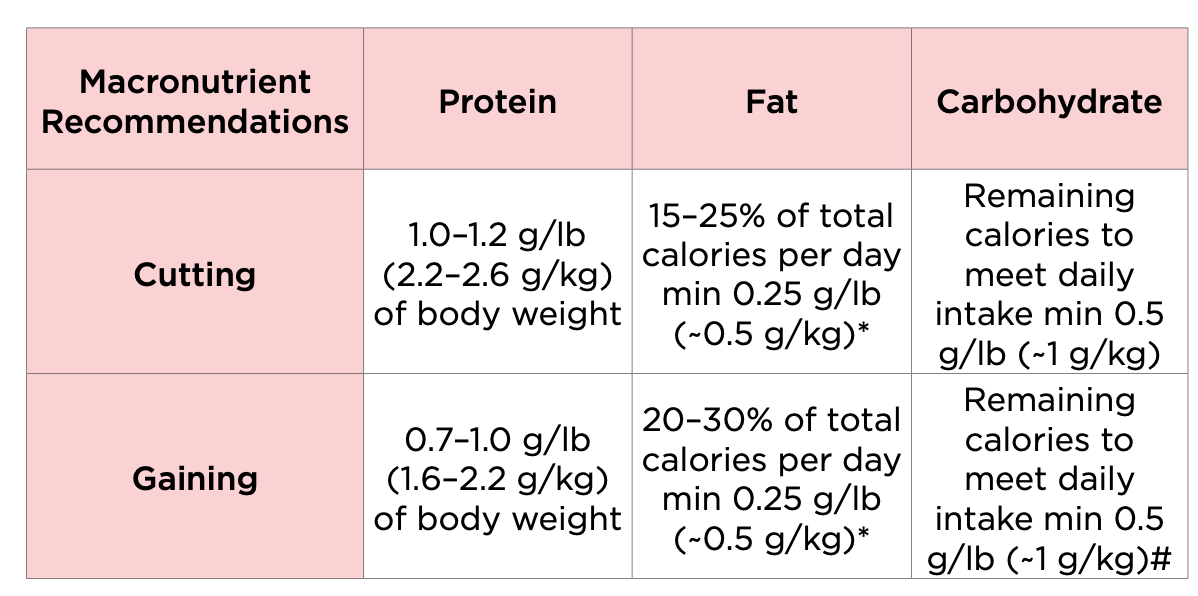
Minimum Recommended Carbohydrate and Fat Intake:
- Establishing minimum intakes for carbs and fats is crucial as they are primary energy sources and essential nutrients.
- Minimum intake recommendations are 0.25 g/lb for dietary fat and 0.5 g/lb for dietary carbohydrate.
- Maintaining these minimums may require accepting a slower rate of weight loss if necessary.
- Slower weight loss is preferred over dropping fat or carbohydrate intake below these minimums for better muscle mass retention.

Setting Macros for a Gaining Phase:
- Athletes in a gaining phase have different macronutrient needs than dieters.
- Protein intake between 0.7–1.0 g/lb of body weight is recommended for those in a surplus.
- The range of 0.7–1.0 g/lb of body weight is likely to maximize the benefits of a high-protein diet.
- Fat intake can be higher (20–30% of total calories) during a gaining phase.
- A focus on calories and protein is often sufficient during surplus periods.
Example Gaining Calculations:
- An example of calculating macronutrient intake for an individual in a lean gaining phase is provided.
- Calculations are based on a daily calorie goal and protein intake, with fat and carbohydrate determined from there.
Example Cutting Calculations:
- An example of calculating macronutrient intake for an individual in a fat loss phase is provided.
- Calorie reduction and protein intake adjustments are made, with fat and carbohydrate calculated accordingly.
Who Should Use These Recommendations:
- The recommendations provided are suitable for approximately 80% of individuals who are not overweight, regularly engage in weightlifting, and are not in the later stages of life.
- Factors like age, insulin resistance, and individual responses to macronutrient ratios may influence dietary needs.
How to Determine a Higher-Fat, Lower-Carb Diet:
- For those unsure if a higher-fat, lower-carb diet is suitable, a self-trial method is recommended.
- Run a 1-month trial with 40% fat intake, followed by another month with 20% fat intake while keeping other factors constant.
- Track mood, energy, and training quality daily and compare results.
- Repeat the trial to ensure consistency in findings.
Fiber:
- Fiber intake is essential for gut health, nutrient absorption, and appetite control.
- Recommendations for daily fiber intake are around 25 g for women and 38 g for men in the US.
- It’s important not to exceed 20% of total carbohydrate intake from fiber.
- Counting fiber as part of your carbohydrate intake is recommended for consistency in tracking.
➡️ Read More: An Open Letter to My Future Son & Daughter: Step 1
☞ Level 3: Micronutrients
Micronutrient Intake:
- Micronutrients are essential nutrients required in smaller quantities compared to macronutrients (proteins, fats, carbohydrates).
- Two categories of micronutrients: minerals (inorganic) and vitamins (organic).
- Macrominerals include calcium, phosphorus, potassium, sulfur, sodium, chlorine, and magnesium. Trace minerals include iron, copper, cobalt, zinc, molybdenum, iodine, and selenium.
- Fat-soluble vitamins (ADEK) are absorbed with fat and stay longer in the body, while water-soluble vitamins (B and C) are excreted quickly and require regular intake.
- Micronutrient deficiencies can impact overall health, gym performance, hunger levels, mental well-being, and muscle gain.

Implementing Micronutrient Intake:
- Shift from an “exclusive” mindset (focusing on macronutrients only) to an “inclusive” one, emphasizing micronutrient-rich foods.
- Be cautious when dieting, as it can lead to micronutrient deficiencies, particularly in vitamin D, calcium, zinc, magnesium, and iron.
- Zinc deficiency can reduce metabolism, while iron deficiency can affect strength.
- Calcium is vital for bone health, and deficiencies can be corrected through dairy or supplementation.
- Maintain variety in your diet and include fruits and vegetables to cover micronutrient needs.
- Recommendations: At least one serving of fruits and vegetables per 1000 calories when gaining, and one serving per 500 calories when dieting.
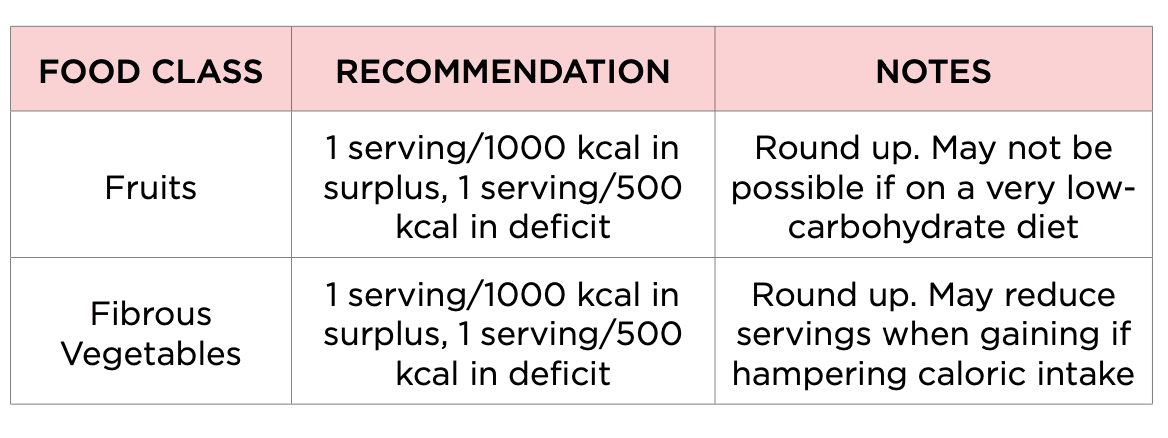
Fluid Intake:
- Consider all non-alcoholic fluids, including coffee and tea, in your daily fluid intake.
- Recommended daily fluid intake is about 2/3 of your body weight in pounds, converted to fluid ounces (e.g., 140 fluid ounces for a 210 lb person).
- Alternatively, drink according to thirst and assess hydration by monitoring urine color. Clear or light-colored urine indicates good hydration.

Customizing Fluid Intake:
- Individual factors such as sweat rate, activity level, and climate can influence fluid needs.
- Adjust fluid intake based on thirst and urine color, aiming for clear urinations throughout the day.
- A 2% decrease in body weight from fluid loss can impact aerobic performance, while a 3% decrease can affect strength.
➡️ Read More: An Open Letter to My Future Son & Daughter: Step 2
☞ Level 4: Nutrient Timing
Different Ways to Implement Refeeds: While the text discusses two consecutive refeeds or three refeeds spread throughout the week as simple approaches, it emphasizes that there are other ways to implement refeeds, and what’s optimal can vary greatly among individuals.
Refeeding and Leanness: Refeeding becomes more crucial as you become leaner, especially when aiming to preserve lean mass and energy expenditure during a calorie deficit.
Caloric Intake on Training vs Off Days: Adjusting calorie intake on training days versus non-training days is generally unnecessary, except in cases of significant energy disparity between low and refeed days with a high frequency of refeeds.
Meal Frequency: Research suggests that eating between three to six meals per day is a reasonable range for most people, with minimal impact on body composition. Very low or very high meal frequencies can affect adherence and hunger control.
Consistency in Diet Structure: Having a consistent structure in your diet, including regular meal times and balanced nutrient distribution, can promote adherence and reduce decision fatigue.
Variability in Meal Frequency: While most individuals may benefit from three to six meals per day, some people might do well with higher or lower meal frequencies. It’s important to find what works best for your individual needs and preferences.
Meal Frequency for Bulking: Larger individuals with high caloric needs during a bulking phase might require more frequent meals to meet their daily caloric goals.
Peri-Workout Nutrition: The timing of nutrient intake around workouts can be important, with recommendations for consuming protein and carbohydrates before and after training, especially when dieting.
Considerations for Cutting: When cutting, it’s recommended to have a meal containing both protein and carbohydrates 1-2 hours before and after your workout to support performance and prevent excessive fatigue.
Considerations for Gaining: During a gaining phase, the timing of meals around workouts is less critical, and it’s generally advised to ensure you have protein in your system before and after training.
Considerations for Extremely Active Athletes: Athletes engaging in prolonged, high-intensity training sessions may benefit from pre, post, and intra-workout liquid nutrition to support performance.
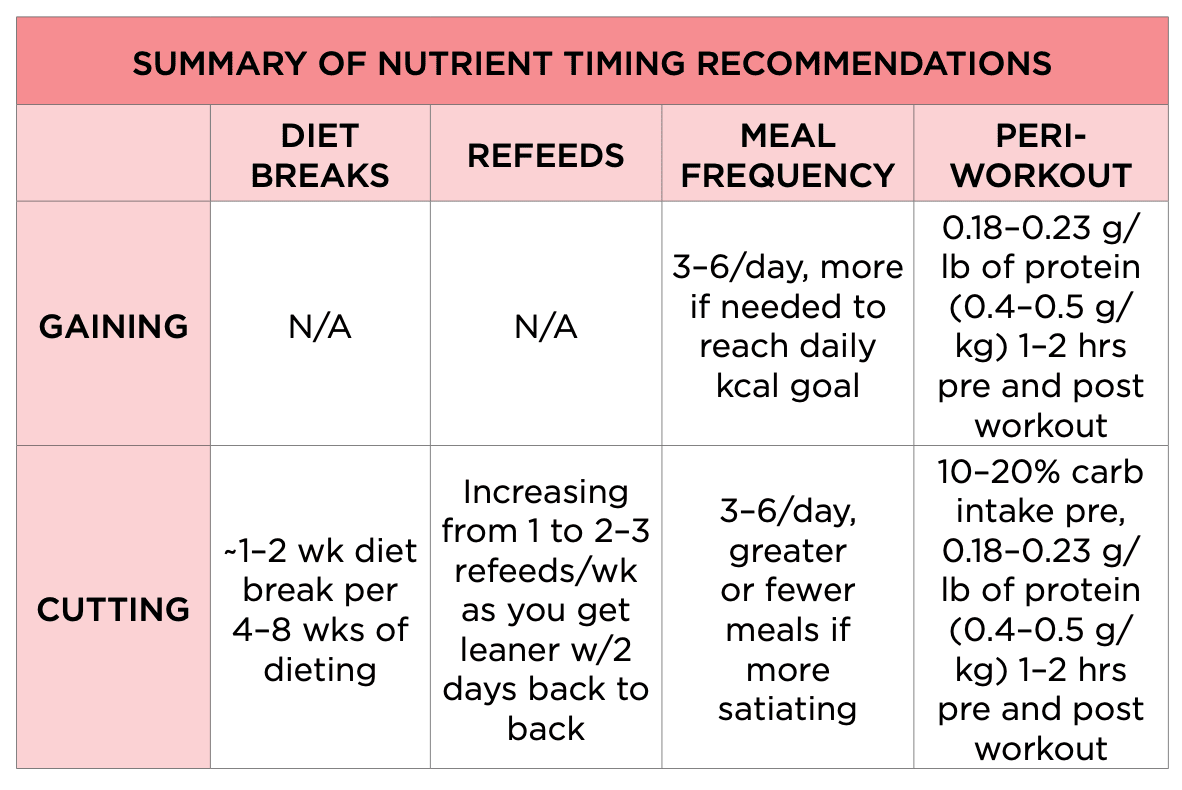
☞ Level 5: Supplements
Vitamin D3:
- Vitamin D is essential for health and is typically synthesized in the skin when exposed to sunlight.
- A lack of sun exposure, which is becoming more common, makes dietary sources of Vitamin D important.
- Severe deficiency can lead to osteoporosis, cancer, hypertension, and autoimmune diseases.
- Dietary sources of Vitamin D include fatty fish and fortified products like cereals, dairy, and orange juice.
- Beef, pork, and eggs contain smaller amounts of Vitamin D.
- Vitamin D insufficiency is common worldwide, particularly among indoor athletes and those in overcast climates.
- Correcting Vitamin D insufficiency may improve immune function and reduce illness risk.
- Supplementation with Vitamin D3 is recommended if blood tests confirm insufficiency, with daily dosages of 20-80 IU/kg.
Creatine Monohydrate:
- Creatine is naturally produced in the body and is also found in meat.
- Creatine monohydrate is the most effective and affordable form of creatine.
- To benefit from creatine supplementation, an intake of 0.02 g/lb of body weight per day is recommended.
- Timing of creatine consumption doesn’t significantly affect long-term results.
- Loading creatine can be beneficial when starting during a diet to avoid weight gain.
- Creatine is primarily useful for improving strength, power, and muscle mass.
Caffeine:
- Caffeine is a powerful stimulant that can improve acute performance and reduce tiredness.
- It is effective for enhancing both resistance training performance and aerobic endurance.
- Caffeine tolerance can develop with regular use but doesn’t affect its tiredness-suppressing effects.
- It’s advisable to keep caffeine intake as low as possible to maximize its stimulatory effects.
- Caffeine’s efficacy varies depending on individual response and tolerance levels.
- Caffeine should be taken with caution before workouts to avoid jitteriness and sleep disruption.
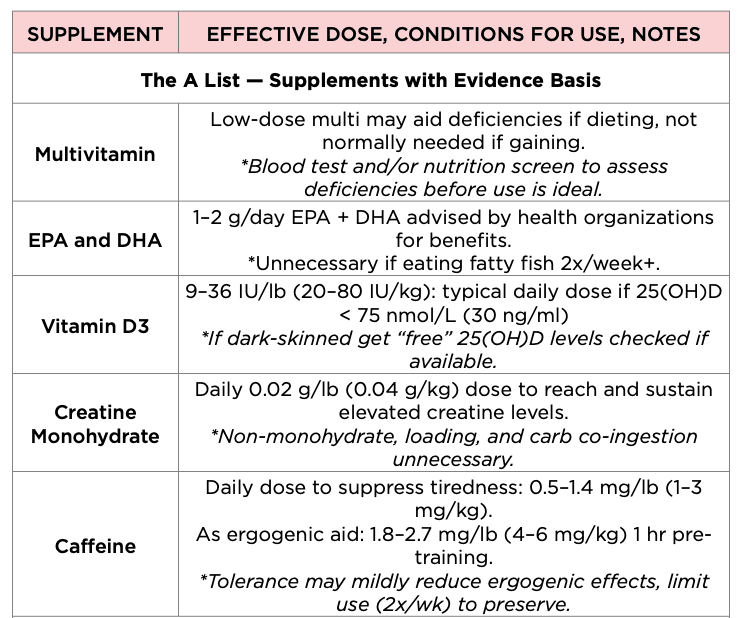
☞ Behavior and Lifestyle
Identify Your Weak Points: Determine which aspects of your nutrition, such as fluid intake, fruit and vegetable consumption, or protein intake, need improvement.
Establish a System: Create a system to ensure you consistently meet these nutritional goals. This could involve daily routines or specific strategies like making a protein shake with fruit and water.
Monitoring and Adjusting: Regularly assess your progress, especially if your goal is weight-related. Make adjustments based on your internal cues and progress toward your goals.
Weight Gain or Loss Goals: Adjust your intake based on your goals. If you’re aiming to gain weight, focus on feeling fuller after meals and use shakes or liquid meals. If you’re trying to lose weight, decrease portion sizes and eat more slowly.
Maintaining Leanness: Continue focusing on your gym progress and make dietary adjustments as needed when you get leaner or hungrier.
Scale Use: Use the scale as needed. Frequent weigh-ins may be necessary for weight gain, while those maintaining leanness can avoid the scale if their appearance aligns with their goals.
Non-Competition Fat Loss: If you’re not a competitor but want to maintain a muscular physique, prioritize sustainable habits, use internal cues, and aim for gradual progress.
Establishing Habits: Select 3-4 actionable habits from the provided list and work on incorporating them into your lifestyle for a month or two. Assess your physique visually rather than relying solely on the scale.
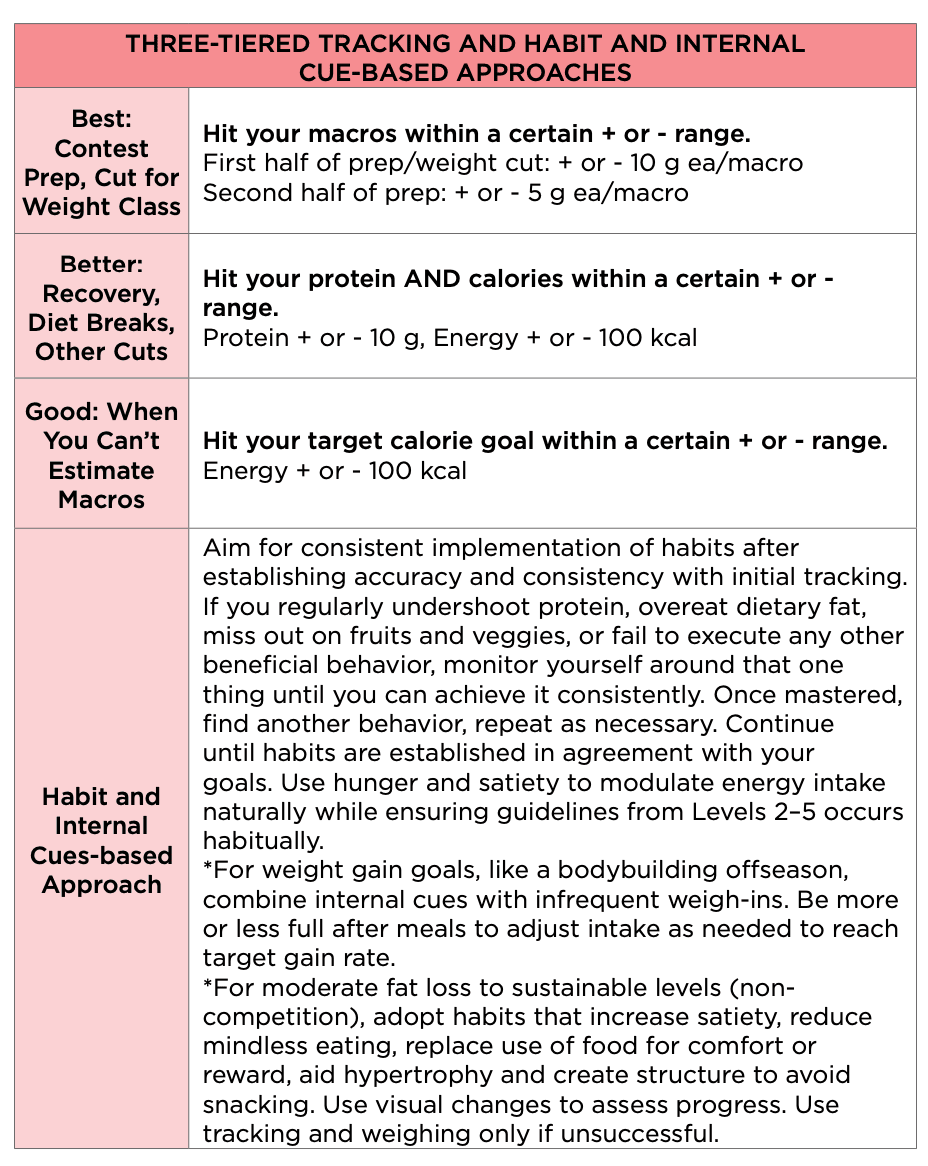
Support System: Communicate with your friends and family about your fitness journey. Explain your goals, why they matter to you, and how they can support you.
Balancing Social Life: Strive to minimize the social impact of your dietary choices on your loved ones. Find ways to maintain social connections without compromising your goals.
Helping Others: Be empathetic and open-minded when people seek advice. Avoid unsolicited advice and focus on providing information without attacking individuals or their beliefs.
⬇️ More from thoughts.money ⬇️



